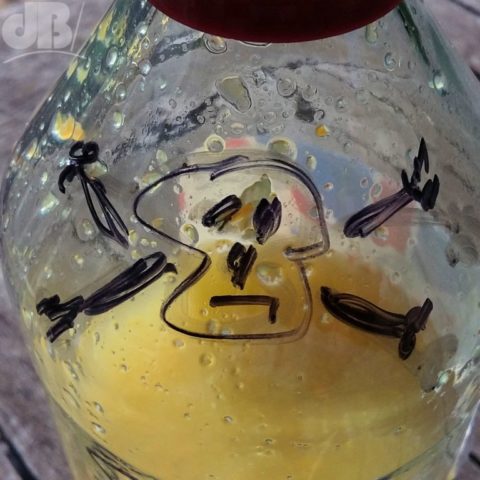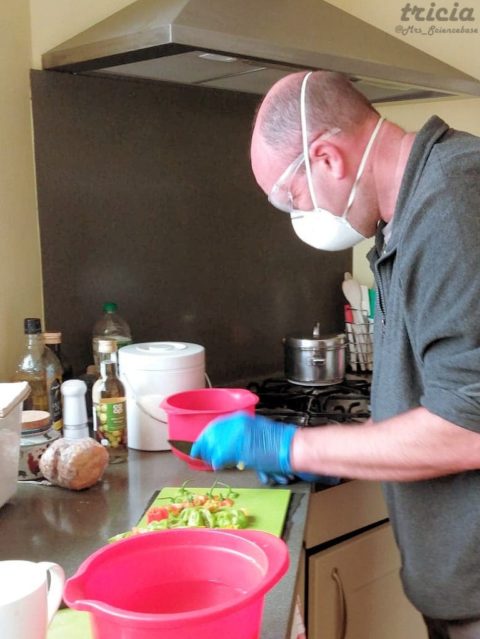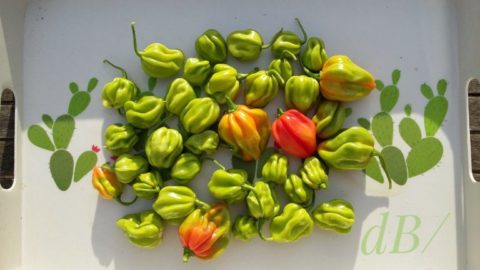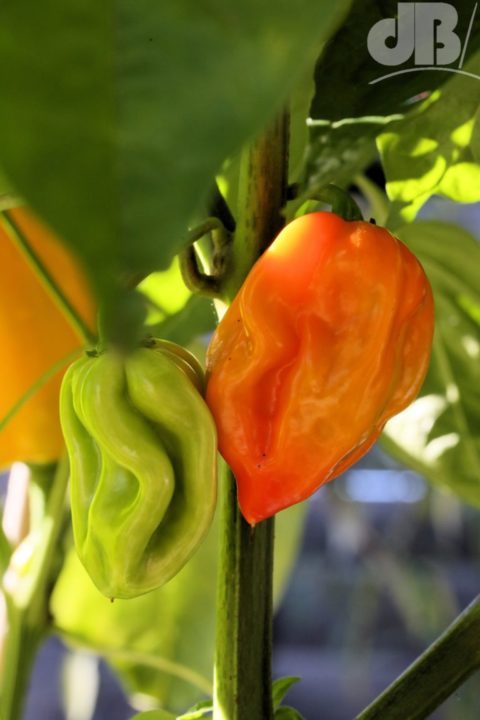UPDATE: I blitzed them in the food processor today and converted the jar of pickled chillis into a lethal cocktail for drizzling into curries and marinades etc. Thought I had better put a hazmat type sign on the bottle.

Turns out these are Scotch Bonnets, up to 400,000 Scoville units in terms of capsaicin concentration. I’ve now chopped, deseeded and blanched half a pound of them to freeze and pickle.

I wore rubber gloves, a facemask and goggles while I did so, but the house is now full of their volatiles and neither Mrs Sciencebase nor myself can stop coughing and sneezing. I just touched my face with a formerly gloved finger that I thought I’d washed thoroughly and the skin there is sizzling gently…why do we use these weapons on mass destruction in food again, remind me?

UPDATE: I was talking chillis in the pub last night with biochemist and brewer friend Mark. He reckons the best thing to do is blend them up with some salt and white wine vinegar or cider vinegar, seeds and all, to make a useful drizzle to add a bit of fire to anything you cook, as and when. He also warned against adding anything fresh and rottable, such as freshly plucked chillis to oil to make a chilli oil, for instance, as there is a significant risk of botulism with such homemade products unless you add the requisite preservatives that defeat Clostridium botulinum.
Apparently, the chilli peppers I have grown are habanero Scotch Bonnet (1000s times hotter than a jalapeno on the Scoville scale). I chopped one without the seeds into scrambled eggs for lunch and almost couldn’t breathe while they were frying…my stomach is still complaining three hours later, my nose is running, and my lips feel like I’ve been chewing wasps. I only ate the tiniest fragment and none of the seeds. Although there is usually very little capsaicin in chilli seeds its highest concentration being found in the pith that attaches them to the interior of the fruit.
My chillis are now destined for homemade chilli pizza oil, I reckon. I daren’t cook with them again. They’re weapons grade.

In case you were wondering: The Scoville scale is a subjective measure of the heat of peppers, or other spicy foods, basically acting as a proxy for capsaicin concentration. Capsaicin is perhaps the most well known of the many related pungent capsaicinoids compounds in chillis. The scale is named for American pharmacist Wilbur Scoville, whose invented an organoleptic test for chilli heat in 1912. It is still discussed but high-performance liquid chromatography (HLPC) provides a more objective way of testing capsaicinoid concentration.
Capsaicin has the chemical name 8-methyl-N-vanillyl-6-nonenamide) it is a serious irritant to all mammals causing a burning sensation in any tissue with which it comes into contact, particularly sensitive parts of the body such as the eyes and nose, any part of the alimentary tract from top to bottom, and for some unfortunate chilli “chefs” who don’t wash their hands thoroughly after handling, any part of the reproductive tract too…hence the phrase – Chilli Willy – familiar to many waiters in restaurants serving spicy food.
Ironically, capsaicin has been used as a topical painkiller (in shingles for instance) and it has also demonstrated antifungal activity. Indeed, it may well have evolved in the plants for this purpose to protect the seeds, which are dispersed in avian guano (birds don’t feel the burn).